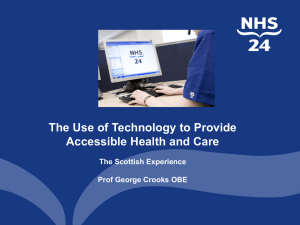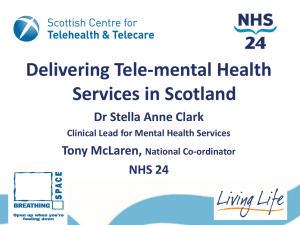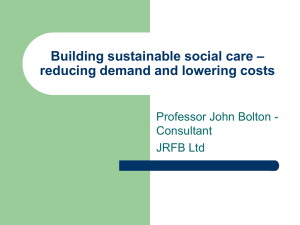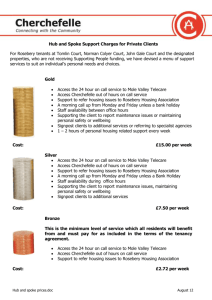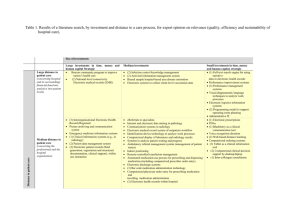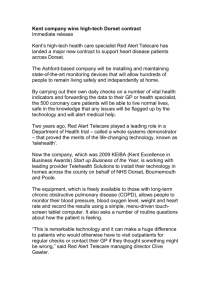Health & Social Care Change Agent Team
advertisement
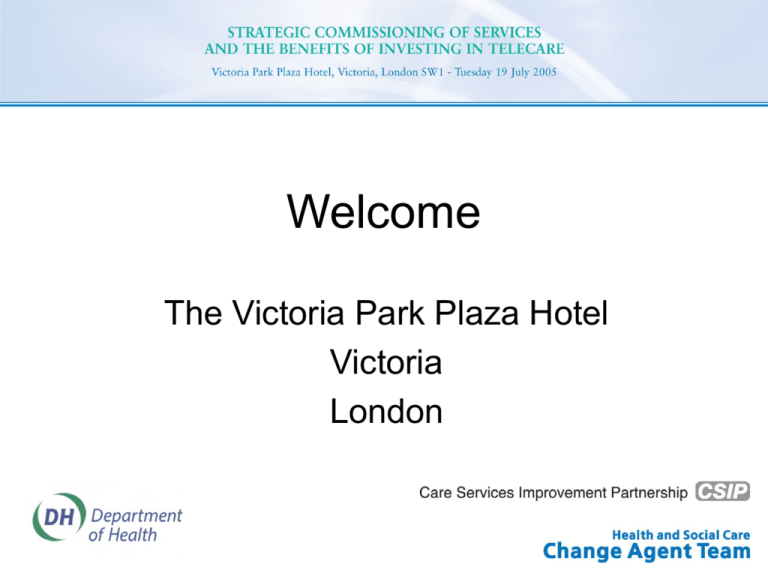
Welcome The Victoria Park Plaza Hotel Victoria London Chair’s Welcome Richard Humphries Chief Executive Care Services Improvement Partnership The Gift of Peace of Mind Liam Byrne MP Parliamentary Under Secretary of State for Care Services For printed copies of each presentation please complete the Conference Evaluation sheet (in the handout pack) at the end of the day and hand it to the conference registration desk Health & Social Care Change Agent Team STRATEGIC COMMISSIONING OF SERVICES AND THE BENEFITS OF INVESTING IN TELECARE LONDON Tuesday 19 July 2005 Health & Social Care Change Agent Team ARE YOU READY TO SPEND THE £80 MILLION? Ian Salt C.S.I.P. National Lead - Telecare Health & Social Care Change Agent Team “In looking at the new funding, as a Director of Social Services I might be asking myself……..” 1. Is there any evidence for telecare – is it cost-effective? 2. How do I deal with the ethical issues like consent? 3. How do I get Social Services, Health, Housing and the independent sector involved in improving services? 4. How does telecare fit in with other plans and priorities for promoting independence and dignity? 5. How does telecare become a mainstream service? Health & Social Care Change Agent Team “Is there any evidence for telecare – is it cost effective?” • Examples of good practice and innovation showing that telecare can help reduce care home and hospital admissions and support independence programmes • Innovative housing schemes have led the way in providing telecare support • Payment by Results and the National Tariff opportunities for PCTs to monitor long term conditions outside of hospital • The CSIP Telecare Implementation Guide and factsheets provide information, checklists and contacts including local services and telecare experts Health & Social Care Change Agent Team “How do I deal with the ethical issues like consent?” • Users could benefit from telecare • Care should be taken to obtain consent and agreement • Follow-up, monitoring and review will ensure that telecare meets the needs of users and is not intrusive • Complex situations will need special consideration • Innovative work would need local ethics committee consideration – a factsheet is available Health & Social Care Change Agent Team “How do I get Social Services, Health, Housing and the independent sector involved in improving services?” • ICES Section 31 or other existing partnerships to bring people together – this could leverage in extra funding • Users may have reduced hospital admissions and those supported by health services may need less care,– whole systems thinking is vital • Telecare could provide considerable benefits for carers and families • Fair Access to Care Services and Single Assessment will enable services to be focused on users and carers Health & Social Care Change Agent Team “How does telecare fit in with other plans and priorities for promoting independence and dignity?” • Audit Commission and the Health Select Committee reports • The Green Paper on Adult Social Care includes telecare • Standards in several of the NSF’s could be achieved using aspects of telecare ( long term conditions, falls strategies, intermediate care ) • Telecare could support people as part of palliative care programmes • ‘Improving the Life Chances of Disabled People’ has many references to assistive technology Health & Social Care Change Agent Team “How does telecare become a mainstream service?” • Innovation and programme evaluation identifies the value of telecare services with a sound evidence base and demonstrates value for money • Partnership working provides synergy and leveraging of additional, recurring funds to provide long term development • A viable service option for health, housing and social services provision with clear links to their strategies, policies, commissioning plans and service priorities • Involving users and carers through consultation and care planning focuses on independence, dignity and choice • The CSIP Guide and factsheets support local plans Health & Social Care Change Agent Team Implementation of telecare Project Mgr Suppliers Ethics Awareness Procurement Contracts/SLAs Pilot(s) Protocols Charging Commence FACS, SAP Review Health & Social Care Change Agent Team Implementation of telecare Project Mgr Suppliers Ethics Pilot(s) Charging FACS, SAP Awareness, training Funding >Procurement Contracts/SLAs Protocols Commence Review Health & Social Care Change Agent Team Implementation of telecare – too long Project Mgr Suppliers Ethics Pilot(s) Charging FACS, SAP Awareness, training Funding >Procurement Contracts/SLAs Protocols Commence Review 6 months 6 months 6 months 6 months 6 months Health & Social Care Change Agent Team Implementation of telecare – telescoping the timeline using the Guide and Factsheets Telecare Champion Funding and 2005/6 Plans Evidence-base, suppliers, procurement Partnership working Ethics FACS, SAP, fairer charging Awareness, training Contracts/SLAs Protocols Commence Review July 2005 Dec 2005 April 2006 Sept 2006 Health & Social Care Change Agent Team SO - ARE YOU READY TO SPEND THE £80 MILLION? We need to share information as it starts to emerge We need to gather evidence so that we can move this telecare agenda forward together. Ian Salt C.S.I.P. National Lead - Telecare Health & Social Care Change Agent Team FOR MORE HELP AND ACCESS TO THE CSIP TELECARE IMPLEMENTATION GUIDE PLEASE VISIT OUR WEB SITE: www.icesdoh.org/telecare www.changeagentteam.org.uk/telecare For printed copies of each presentation please complete the Conference Evaluation sheet (in the handout pack) at the end of the day and hand it to the conference registration desk Getting the Right Balance of Care in your Economy ‘Strategic Commissioning of Services and the Benefits of Investing in Telecare’ Workshop 19 July 2005 Steve Arnold Director, Integrated Care North West London SHA 20 Long Term Conditions: • are enduring • are not curable and require ongoing care • will get progressively worse What’s included?: • arthritis, diabetes, heart failure, COPD • mental health • renal dialysis, cancer and HIV/AIDS • Sickle Cell and Thalassemia • NSF on Neurological Conditions The challenge …. • 17.5m people with LTC, 8m with multiple LTCs • Discomfort and stress an everyday reality • Care has been reactive, unplanned and episodic, reliant on hospitals • 5% LTC inpatients = 42% of all acute bed days • LTCs account for 80% of GP attendances • Only 50% medicines taken as prescribed Strategic Aims • Embed a systematic approach across health and social care • Reduce reliance on secondary care – increase primary, community and home support • Deliver high quality personalised care • Support for self-care – linking to ‘Choosing Health’ and healthier choices National Targets • April 2008 - reduce Emergency Occupied Bed Days by 5% • April 2008 - identify the cohort of Very High Intensity Users - est. 240k nationally • April 2008 – all VHIUs have care plans and are case managed • April 2007 – complete appointment of Community Matrons - 3,000 nationally Stratifying need and matching care Case Management Disease Management Supported Self Care Level 3 Highly complex Patients (5%) High risk Patients (15%) Level 2 Level 1 Low risk Patients (80%) POPULATION WIDE PREVENTION ‘Supporting People with Long Term Conditions – An NHS and Social Care Model’ (Jan 2005) Albert’s story ….. present day •Albert is 72, lives alone - diagnosed with COPD 15 years ago •30% of normal lung function at rest - severe breathlessness especially when he exerts himself, even in the most routine ways •underweight; anxious, depressed, prone to panic; he feels hopeless and that he can’t cope • regular exacerbations - admitted to hospital - 15 days LOS •delay in notifying the GP and in getting support - re-admitted to hospital •not able to attend the follow-up OPD appointments offered at the hospital •GP does not normally visit •treatment - oxygen therapy, steroids, antibiotics and regular use of inhalers, although he would often forget to take his medication •meals delivered - carer support Albert’s story ….. 2010 •Co-ordinated by Primary Care Centre - Nurse Case Manager contacts him regularly both by telephone and in person •Provides routine information daily through a hand held computer to the PCC assessed daily •Contact him by video link re possible exacerbation - advice about additional selfmedication •Other reports, inc weather conditions •Urgent visits as appropriate •Admissions to hospital reduced – and then: – PCC stays in touch – LOS reduced - usually 3 to 4 days – Co-ordinated discharge • ‘Direct payments’ funds gardener •Calmer and spends lots of time admiring his newly reclaimed garden. Lessons for the Telecare agenda • Whole systems approach • Links to the broader policy agenda • Staff training inc decision support • Awareness raising amongst users • What can the industry contribute? Long Term Conditions – take home message Be ambitious – this is about transformation REFRESHMENTS For printed copies of each presentation please complete the Conference Evaluation sheet (in the handout pack) at the end of the day and hand it to the conference registration desk Newham Home Monitoring Project : Using Telecare to Integrate Health and Social Care About Newham About Newham • Ranked 4th in Jarman scores • 62% of population are from black and ethnic minorities • High proportion of under 24s • Significant population growth forecast Health in Newham • Major areas of health inequality • Significant burden of long term conditions particularly diabetes, cardiovascular disease and respiratory disease • Age profile of LTCs different • Huge potential for improvement Mortality trend for coronary heart disease, in people aged under 65 England London Newham 80.00 rate per 100,000 70.00 60.00 50.00 40.00 30.00 20.00 10.00 0.00 1993 1994 1995 1996 1997 1998 1999 2000 2001 Mortality trend for stroke, in people aged under 65 England London Newham 25.00 rate per 100,000 20.00 15.00 10.00 5.00 0.00 1993 1994 1995 1996 1997 1998 1999 2000 2001 A Relatively Small Number of Patients Account for a Large Share Costs Hospitalized Patients and % of Total Patient Days 100% 100% 14.3% 26.4% 80% 19.0% 60% 80.0% 27.1% 40% 74% 20% 60% 15.4% 80.0% 29.9% 86% 40% 20% 10.0% 0% Percent of Total Percent of Total 80% Hospitalized Patients 10.0% 27.5% 7.0% 3.0% Total Patient days All London 40.4% 0% 7.0% 3.0% Hospitalized Patients Total Patient Days Newham PCT What works in LTC management ? • Managing the whole package of needs • Single point of contact, particularly to promote • • • • • good cross sectoral and multidisciplinary working Good quality, accessible information Proactive management Timely, effective and proportionate response in and out of hours Involved and informed patients and carers Tailoring to individual needs, especially in complex cases Aims of the Home Monitoring Project • Increase patients’ knowledge of their condition • Identify risk factors/ deteriorating condition and • • intervene early Increase access to information 24hrs a day for health & social care professionals caring for the patient Manage health & social care needs and patient anxiety Target Group • Older people living at home beginning to • • • develop a pattern of regular admissions / attendance at A&E At least one chronic condition Anxious / socially isolated and in need of support Those with language needs and early stage cognitive impairment actively involved What the project consists of Single Assessment Risk Identification Care Companion Web Record Case Manager based in Local Authority Call Centre Individual Escalation Protocol AMD Care Companion System Assessment Unit Assessment Unit + wireless devices Assessment Unit + wireless devices + videophone Potential Value of Telecare • • • • • • • • Extend care to home setting Supports patient education and concordance Relieves pressure on carers Integrates in and out of hours care Facilitates proactive care High quality reliable information for decision making Underpins information sharing and joint planning Enables most effective use of health / social care resources Lessons Learned in Newham • Steep learning curve for NHS and independent sector • Dedicated resources essential • Compatibility between systems needed • Risk issues (clinical, financial) • Enthusiasm from staff and patients For printed copies of each presentation please complete the Conference Evaluation sheet (in the handout pack) at the end of the day and hand it to the conference registration desk Telecare A Durham Perspective Content Part One (John Thornberry) We like telecare because There are challenges Our strategic approach Part Two (Dennis Scarr) Pathfinder programme 3 examples We like telecare because it…. Increases choice for people Helps to manage risks in community care Achieves targets and performance Helps with CSEP/Gershon Changes cultures and practices Some Challenges Complex organisational arrangements Overlapping policy initiatives Tight budgets Silo working practices Development to mainstream Durham Strategic Approach Whole systems approach Partnership working as a key to success Countywide groups for older people, CEB, Supporting People Locality Boards with SSD, DC and PCT At Home and in touch project to link IT with practice Pathfinder Programme Three Examples We are sometimes providing the wrong services at the wrong time to the wrong people -we need to review how and where we spend our resources The rate of changes in health care must link to changes in social care and housing provision-The key providers must co-ordinate their service changes more effectively Not developing the types of care services needed in the future fast enough - we are too slow! A case for improved integrated working in local communities We are still driving a reactive approach to care and housing provisionwe need to develop enhanced preventative services 33% increase in people needing care services in next 10 yearsdemand is increasing more quickly than ever before Low overall user expectation user expectations will increase in both needs & wants Govt will no longer tolerate poor performance or slow progresscash rewards are available to those willing to change Assistive Technology and Extra Care Housing Sycamore Lodge – Hanover Extra Care Remote Health Monitoring & CDM ‘Well Elderly Clinic’ Telemed / Community Alarms / GP’s / Service User Making it happen Early learning Assistive Technology and SCATS Sedgefield Community Assistive Technology Service ‘helping someone with memory related problems remain at home….’ Telecare sensors/ Community Alarms/Warden Service Making it happen Early learning Assistive Technology & Integrated Teams Integrated Teams for services to Vulnerable Adults – Social Care & Health / Health / Housing Support services. Assistive Technology / Community Alarms/Warden Services Single Assessment Process Making it happen Early learning For printed copies of each presentation please complete the Conference Evaluation sheet (in the handout pack) at the end of the day and hand it to the conference registration desk Helping people to stay at home findings from an evaluation of Northamptonshire's Safe at Home Project. John Woolham Senior Research Officer Northamptonshire County Council Community Services Directorate July 2005. 18 March 2016 Safe at Home: background Northamptonshire’s involvement in the EU funded ASTRID project Putting principles into practice – the Safe at Home project Safe at Home: project structure Three full time project workers located in Care Management teams and responsible for assessing referrals, identifying and obtaining technology needed and arranging its installation 3 ‘Demonstration houses’ to show technology in action to professionals, carers, and service users. Project depends on multi-agency partnership working and multi-disciplinary professional skills within its management groups Safe at Home: what it does in practice: The story of Mrs White and her gas cooker….. The Problem: Forgets to light gas cooker after turning it on. Risk of suffocation or explosion High level of concern from neighbours and relatives The Solutions? Admission into care Disconnect cooker Substitute gas for electric or microwave Use technology to manage risks Safe at Home: evaluation objectives To assess the reliability of any technology used in the project To assess the extent to which any technology used supported unpaid carers and relatives To assess the success with which technology helps service users to maintain their independence To examine the cost effectiveness of the project Safe at Home: methods Longitudinal design – 21 months Criteria for inclusion in evaluation: Met criteria for referral to project permission given to use data for research purposes Control group from Essex social services to collect some outcome and cost data No sampling. Safe at Home: methods There was a fairly high drop out rate before a service was provided Safe at Home service users and the control group were very well matched Total no. referrals = 326 Total no. assessments = 291 SAH User group (n= 233) Mean age Gender Ethnicity Living alone Total no. people who received technology = 233 Comparator group (n= 173) 80.2 (SD=7.97) 79.4 (SD=7.41) M = 62 (27%) M=48 (27%) White = 97% Asian/Asian British = 1% Black or Black British = 1% Chinese = <1% White = 100% Y= 66% Y= 40% Diagnosis dementia of Y= 90% Y = 100% Presence unpaid carer of Y = 87% Y = 94% 19.9 (SD= 6.07) (n=87) 18.9 (SD= 5.05)(n=93) Mean MMSE Safe at Home: Objective 1. The reliability of the technology Over 50 different kinds of device were used Some were simple ‘stand-alone’ devices that don’t need to be installed Some were telecare devices which relayed messages to a local call centre so a ‘social response’ could be provided. Reliability and effectiveness checked every three months by project workers 91% of devices worked perfectly over the course of six reviews. Safe at Home: Objective 2: The impact of the project on relatives and unpaid carers 5 4 4.7 4.4 4.3 4.1 4.1 4 3.9 3.8 4.84.7 4.4 4.1 4.3 4.1 3.63.5 4 3.63.5 3.8 3.93.8 3.93.9 3.93.8 3 Before After 2 Demands for attention Health concerns Standard of living Inability to have holiday Lack of pleasure Feelings of frustration Feelings of embarrassment Upset to household routine Worries about person cared for Feelings of depression Difficulties coping 0 Interrupted sleep 1 Fear of accidents/dangers 123 relatives and carers were surveyed and 70% replied. A carer stress scale was used to measure the impact of the project. In all but one of the scored items the scale score was lower (i.e. the relative or carer was less stressed) after the project had provided technology. These changes in score were statistically significant in 9 of the 13 items on the scale (w=0.001) Safe at Home Objective 3: Extent to which project supported independent living 12 11 10 8 8.8 9.2 9.2 7.3 7 7.1 6.8 At referral 5.4 5.5 6 4 3.3 2.4 2.3 12 mths later 2.9 2.5 2.5 Behaviours difficult for others Practical issues Ability to maintain control Values beliefs and feelings Physical health Personality & dementia presentation 0 Contact with others 2 Thinking & communication Aggregate score Assessment score profiles for people at referral and 12 month later declined (i.e. showed evidence of slight improvement) in functioning on three of the eight subscales. All sub-scale scores were statistically significant (x2=<0.001) Safe at Home Objective 3: Extent to which project supported independent living 70 60 % who left community A control group was used to compare the rates at which people left the community. People from the control group left the community sooner and in greater numbers: they were four times more likely to leave the community than Safe at Home users. 50 40 Safe at Home 30 Essex comparator 20 10 0 1 2 3 4 5 6 7 8 9 10 11 12 13 14 15 16 17 18 19 20 21 months Safe at Home Objective 3: Extent to which project supported independent living The study considered if other factors might be responsible for these outcomes The composition of the two groups: no sampling occurred the two groups were large and well matched on a range of factors. Provision of care: people from the control received more services, more hours of help more visits. The possibility that the differences may be due to difference in use of ‘anti-dementia’ medication or some kind of ‘Hawthorne effect’ are unlikely but can not be entirely discounted. Safe at Home Objective 4: Cost effectiveness 2,000,000.00 1,705,837.50 1,500,000.00 expenditure The project was extremely cost effective as fewer people spent less time in hospital, residential or nursing care. The net equivalent saving over 21 months was £1,504,773. 1,020,054.00 Safe at Home 1,000,000.00 500,000.00 Essex comparator 568,440.18 477,270.30 127,356.96 15,911.36 0.00 Residential care Nursing care Hospital Safe at Home: conclusions Operational teams need: Training, training, training Access to information about what technology is available and what it does & doesn’t do Ability to obtain relevant technology quickly as well as access to people with the skills to install it safely Need for access to call centre staff who are trained and have the resources to meet the demands of an expanded service To include a social response service If the infrastructure is in place technology can help deliver performance improvements in relation to several social care performance indicators May need to think about re-engineering of services and the creation of new hybrid professional groups. Safe at Home: conclusions Risks Use of technology is ‘technology led’ not determined by need Failure to understand or apply ethical protocols where informed consent to use is difficult or impossible Used as a substitute for social care Safe at Home: conclusions Assistive & telecare technology a win-win situation? Consistent with what most service users would prefer Supports carers Very cost effective. Can be used to Manage risk Provide support and reassurance Predict the occurrence of ‘risky’ activities Limits to use are Availability of technological solutions Infrastructure and will to support Skill and imagination of service providers References Barlow, J., et al. Flexible Homes, Flexible Care, Inflexible Attitudes? The Role of Telecare in Supporting Independence (2003) Housing Studies Journal. Curry, R., et al. The use of Assistive Technology to Support Independent living for Older and Disabled People (2002) ICES/DH. www.ICESDOH.org Telecare Implementation Guidance Pack. (2005) Marshall, M (ed) ASTRID: A Social and Technological Response to meeting the needs of Individuals with Dementia (2000) Hawker, London. Woolham, J. & Frisby, B. Building a Local Infrastructure that Supports the use of Assistive Technology in Dementia Care (2002) Research Policy & Planning Vol 20. No.2. Woolham, J. Safe at Home – supporting the independence of people living with dementia by using assistive and telecare technology (2005) forthcoming) LUNCH AND EXHIBITION For printed copies of each presentation please complete the Conference Evaluation sheet (in the handout pack) at the end of the day and hand it to the conference registration desk Making Your Investment Decisions Work Kent Telehealth Evaluative Development Pilot Peter Gilroy Chief Executive Kent County Council A Personal Perspective on the future of social work & social care services in the UK (Kent Social Services & Pavillion Publishing, 2004) “Services of the future must have at their core a ‘customer-care’ ethos and shift away from paternalistic cultures. Attitudes are changing and judgements made by the general public on the quality of public, social-care services will not be determined by what we say but what they taste, see and feel. They will be the ultimate arbiters as to whether we are serious about modernising public services.” Why Local Government? A Modernising Force Financial Savings Family of Services Modern and more effective service to the public Opportunity of a fundamental step change in front end services Better use of public resources: Compliments objectives of our ‘well-being’ powers and provides choice and independence Competence/procurement Capacity/strategic/infrastructure. Kent’s TeleHealth Evaluative Development Pilot Kent Telehealth: Self-management of chronic disease using Telehealth technology. KCC Social Services are the lead agency in this multiagency arrangement Exploiting emerging technology The largest UK pilot to date with up to 300 people. Improve the life outcomes of a pilot group of people in Kent with chronic disease management requirements. Deliver a range of efficiencies across the Health and Social Care spectrum. Links to PSA2 Partner organisations Five PCT’s across Kent. Viterion Telehealthcare LLC are a Bayer-Panasonic Company: Offer comprehensive, affordable, quality healthcare, particularly for people with chronic diseases. Committed to developing with Social Services a UK/Kent version of the US model. Expertise and technology capabilities. Veterans Health Administration (VHA), an agency of the US Department of Veterans Affairs: One of the largest independent health and social care providers in the US. Serving 4.9m patients from a registered client base of 6.9m VHA is affiliated with 107 academic health and social care systems within the US and across the world. For the Kent TeleHealth Evaluative Development Pilot we will be working with VISN 20 – VA Puget Sound Health Care System, Seattle. Kent TeleHealth Evaluative Development Pilot VHA targeted their high cost, high health and social care supporting US veterans with a range of related morbidities Outcomes of the US programme : Hospital admissions reduced by 46% No. hospital bed days reduced by 61% Number of admissions to nursing facilities or similar reduced by 47%. Number of Nursing home or similar bed days reduced by 81%. Reduced (high) hypertensives (blood pressure) by approximately 15% over 4 years. Reduced (mild) hypertensives (blood pressure) by approximately 8% over four Years. After twelve months near perfect score on the cognitive status of the patient. Kent TeleHealth Evaluative Development Pilot Opportunity to reduce admissions and costs in the UK 1.5 million pounds invested by Kent Social Services. Evaluative Trial Programme 18mths. A contribution to the overriding goal of promoting independence. Four key Chronic Diseases: Chronic Obstructive Pulmonary Disease (COPD) & Asthma, Congestive Heart Failure, Diabetes, Depression. Those with 3 + chronic disease conditions will take up 32.5% of GP consultations Chronic Disease Management Social Care professional Health Care professional New vision Modernise Working together Single-Assessment Process Self Managing Care Planning CP Review Well Being Independence Prevention Occupational Therapy Vital Signs Monitoring Healthy Behaviours Health Education Physiotherapy Speech Therapy Mental Health A contribution to the overriding goal of promoting independence What does Telehealth do? This particular TeleHealth Technology consists of: Disease management tools combined with unique user friendly interfaces specifically focused on the needs of older people to easily access and use the technology with confidence. Reporting tools include tracking and alerts Messaging devices, customisable, personalised scheduler, reminder and alarm. Q&A technology Video Link with real-time video monitors and Instamatic digital cameras. Portable, simple telephone connection to the provider via the web Telehealth – The Future? Shift of power from practitioners to users It will be a normal part of public and private infrastructure within 10 years, without diminishing professionals’ quality personal contact with the general public Potential to go beyond intensive case management of people with chronic diseases with the Viterion equipment Integrate TeleHealth into other community settings to promote independence and self-management including the health, education and social-care economies Integrate into other Social Care work, e.g. assessment and referral, care planning, review and single assessment. This form of integration brings back-office efficiencies but more importantly, better outcomes for citizens It offers with other IT products a real step change in the way that the citizens are offered choice and, increasingly for many, self-manage their services ROUND TABLE WORKING For printed copies of each presentation please complete the Conference Evaluation sheet (in the handout pack) at the end of the day and hand it to the conference registration desk Department of Health Conference Strategic Services and Investing in Telecare “Transforming Lives Transforming Services” Tony Hunter, Executive Director, Liverpool City Council and President, Association of Directors of Social Services Themes • • • • • We make lives “bearable” Lots of green shoots Emerging local government roles From telecare to smart living Our leadership challenge We make lives “bearable” • Lives → services: the right way round • Facing reality - “He asked me silly questions I couldn’t answer” - Criteria driven assessments – no added value - Vision statements ¼ hour home care slots - Marginalised social care Lots of green shoots • • • • • Children Act, Green Paper – 150 change programmes From “you need me” to “we need each other” Bottom line: “We can’t go on as we are” Unhelpful barriers coming down, LSPs Technology supported shift from hierarchical management and meetings… • …to fluid networks, focused discussions and contributions to shared agendas Local government of the future • • • • • Force for change - community leadership Heads up enabler, not heads down deliverer Knowledge based interventions Blurred staff/agency roles BPR/ICT around the customer From telecare to smart living • Policy context: shift from yes/no eligibility to wellbeing and inclusion • Telecare part of the former or the latter? • Should any home be without the new, inexpensive “Smart living” Safe Environment Monitoring System? • What’s our role? Sit back, or pro-active? Our Leadership challenge • Getting the “wellbeing” ducks lined up – adults social care, primary health, public health • “Shadow of the leader”: - being empowering, decisive, accountable - listening, reflecting, learning - investing in partnerships - embracing new ideas and technologies • Are we up for it? THANK YOU FOR ATTENDING For printed copies of each presentation please complete the Conference Evaluation sheet (in the handout pack) at the end of the day and hand it to the conference registration desk

